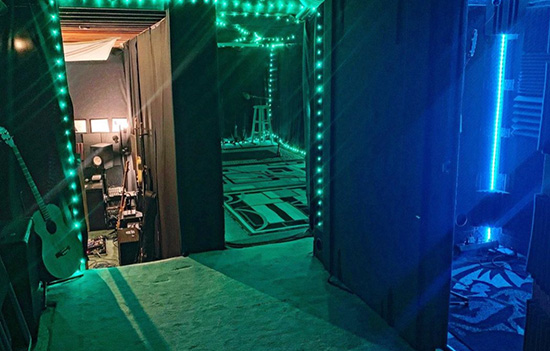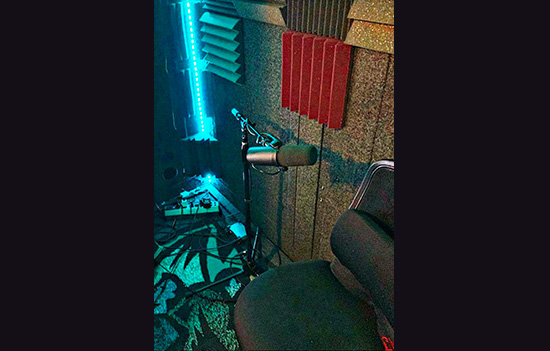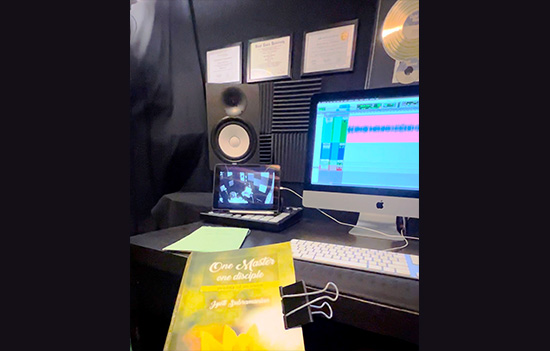- Kriyacharya
Jyoti shares experience of searching for a recording studio in Los Angeles and importantly,
gives Tips for Recording an Audio book.
Recently,
I decided to convert my autobiography One Master one disciple- peeling of an onion, into an audio
book.
By nature preferring written books, I had not invested any time in listening to audio books. It was only recently, after having moved to the US, that I ‘saw’ how many people listen to audio books, while going for a walk, jog or driving. Long commute times and hectic lifestyles had made this a feasible way for people to indulge in their reading habits while getting about their daily chores. This started the germination of the seed to explore audio narration as a mode of literary expression.
Especially interesting is the fact that so far I had ignored this form of expression; having been brought up in an environment of oral recitation of the Ved and Upanishad, the Bhagavad Gita, renditions of Adi Shankaracharya and mantras and chants that had been passed on and kept alive for ages. Thus, I should have been more aware of the power of the spoken word.
My psyche was not jogged to the spoken word inspite of accompanying my parents, as a child, to talks of Swami Chinmayananadaji and many Sundays spent in such recitations in my Baal Vihar classes not to miss all those hours on AIR (All India Radio) listening to Havamahal
and more recently catching snippets of storytelling by Neelesh Mishra.
First Steps
However, once the idea took hold, I started right in earnest to explore the ways and means to achieve this. As is my habit the first option was Do it Yourself; since for years I was engaged in start-up work for my guru, organising events, venturing into uncharted territories, cities and countries to spread awareness of my Guru and his work on Mahavatar Babaji’s Kriya Yoga. Thus, the thought of DIY came rather naturally to me.
I started reading up on home recording studio setups. Tips to convert a clothes cupboard or wardrobe into a home audio recording studio or a portion of a garage were aplenty. All of them required investment into some tools- recording equipment, buffers to reduce echo, stop sounds from penetrating through the walls, water pipes and flushes. It didn’t help that my neighbour played his drums at all odd hours, along with the barking dogs and the gardeners with their gas powered tools in the neighbourhood, soundproofing seemed a distant dream.
Finally,
I decided to take the professional route and engage a recording studio with a
sound engineer. This was in the United States and most studios charged an
hourly fee which increased if you also wanted a professional engineer to sit
through your recordings, which I did.
ACX, the Amazon audible platform had strict specs for the quality of recordings and this was far beyond my expertise. Even though the web is full of sites that give expert help on the use of apps to get the desired outputs. The younger generation may take this as a challenge but I did not want the hassle.
 Space Mint Studio in Los Angelese.
Space Mint Studio in Los Angelese.
Finding a Studio
Next
I started a tour of recording studios in the neighborhood. That was an
adventure by itself. Some were seedy and not very clean whilst others smelled
of weed from musicians who had used the studio the previous night. The majority
of them however were quite professional and had dedicated spaces for small and
large recording needs. Once I contacted them, most studios responded
immediately and most were helpful with their inputs once they learnt I was new
to this.
Almost
all of them suggested that I engage a professional narrator, someone who was
familiar with this medium. But it was my story and I wanted to be the one
narrating. I was not going to be daunted by the task ahead.
Eventually, I was lucky to find a studio that was only a 15 minute commute. Evan Mykl, who owned the studio The Space Mint and also the sound engineer, was very encouraging and helpful. The studio was in his residence and the energy was warm and welcoming. A one person show which was quite after my own heart.
 Place to sit and record.
Place to sit and record.
Learning about Narration Tips
Once
I decided to do the narration myself, started a flurry of reading up on what to
do for voice quality, dehydration, stomach rumbles and yes the biggest
deterrent of them all Phlegm!
How
long I would be able to record each day was another point to ponder over since
most studios required a minimum of two hours of booking. Read on.
Eventually
I came upon a regimen that I am sharing with those who wish to walk this path.
I started this a fortnight before I started recording.
1. Gave
up all caffeinated drinks, coffee being my only one.
2. Drank more water, room temp, with more awareness, gulping the poured water like we do in southern India, without sipping. It helped in keeping the epiglottis clear and throat muscles strong.
3. Started a morning tea drink consisting of mulatthi (liquorice), chotti elaichi (cardamom), and adrak (ginger).
4. Continued with Neti, followed by a practice of my personal dynamic pranayam.
5. Yogasan
to boost upper chest and respiratory organs including neck, upper back and
diaphragm.
6. Yogic face exercises.
7. I also practiced the svar अ आ इ ई etc
and varnamala- क ख ग घ in
an exaggerated manner. Intoning them loudly, often in the shower!
8. Practiced my saptsvarmala as in music सा रे गा मा
with other combinations
9. I gave up all gluten and milk inclusive food- roti and parathas, dahi, milk, ghee, pasta and pizzas. This was a miracle as the throat became completely clear in a few days of abstinence. I am continuing this even after the recording.
10. I found that eating a besan ka chilla, with spinach and
carrots, dhania and ginger before the recording kept my stomach rumbles in
control. Some trial and errors moments did happen as fruit made my stomach
rumble even though it is good for hydration, especially melons, apples and
oranges.
11. Also learnt that the more I chew my food the less the effort the stomach has to make!
It
is amazing how sensitive the recording equipment is and how it catches any
other sound including the breath. Consistent practice of pranayam for decades
helped me with the breath work while reading. Also being a recent grandmother
and reading aloud to my granddaughter for the past two years prepared me for
this task, albeit unknowingly.
 Recording in progress.
Recording in progress.
All
in all the recording went very well and after the first day I realised I could
go on recording for two hours straight without a pause. The complete book of
300 pages took me 18 hours of recording over 10 days. Now it is in the editing
process. In that sense it is similar to a written book that requires painstaking
edits. Similarly, this might require some re-recording later. The editing tools
are quite advanced now and many extraneous sounds can be eliminated if the
narrator has given space for the edit.
Another interesting thing that I noticed was that many of the recordings of Indian authors have been done by American or British counterparts, for e.g. the narration of Paramahamsa Yogananada’s book Autobiography of a Yogi is by Ben Kingsley. Here, there seems to be a reluctance to use Bharatiya voices for recording spiritual books. I too was gently pressurized to get a more ‘understandable’ accent. But hey, I studied in a missionary school and learnt the Queen’s English not for nothing!
Well
the book should soon be available on audible and other audio book platforms. It
did cost me a bit of money to indulge in this wish. It made realize why audio
books are more expensive than written ones.
All photo credits Evan Mykl, The Spacemint Studio, Los Angeles.
Author Jyoti is a Kriyacharya. Her blog
is , U tube Channel
To read all
articles by author